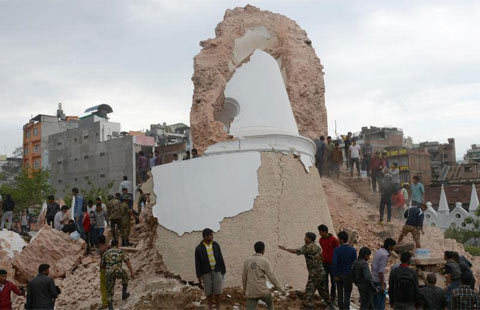Disaster holds lessons for China
Updated: 2015-04-27 07:35
By ZHENG JINRAN(China Daily)
|
||||||||
 |
|
Rescuers work in the county of Gyirong in China's Tibet autonomous region, April 26, 2015. [Photo/IC] |
Scientists urge creation of national program to build tougher houses, improve rescue capacity in regions of highest risk
The devastating Nepal earthquake offers China fresh lessons on how to more effectively protect its citizens and their property in the quake-prone country, Chinese scientists said.
China and Nepal straddle the Mediterranean-Himalaya earthquake belt, a snake-shaped area where many major earthquakes occur.
The Tibet autonomous region, which shares a border with Nepal to the west, suffered casualties in some of its western counties in Saturday's quake. Twenty deaths and 55 injuries were reported on Sunday, and snowy weather made rescue missions difficult.
The aftermath of the magnitude-8.1 quake that hit Nepal suggests that the most urgently needed step toward disaster prevention would be a national program to build tougher houses, scientists said.
Although there are no data indicating disastrous quakes are more frequent now, Gao Mengtan, a scientist at the Institute of Geophysics under the China Earthquake Administration, said that when quakes do happen, they tend to cause heavier human and economic losses.
China's emergency mobilization of resources for disaster rescue and aid missions has improved in recent years, yet there is still much room for improvement in the country's unprecedented urbanization process, said Chen Xuezhong, another researcher at the institute.
Building safety has yet to receive enough attention from the industry, he said.
The Nepal earthquake was the result of the collision of two tectonic plates: the Indian Plate and the Eurasian Plate.
"The energy release in the massive Nepal earthquake has influenced some areas in Tibet and other cities in the western region in China, leaving them affected by earthquakes as well," said Xu Xiwei, deputy head of Institute of Geology.
After the magnitude-9.0 earthquake in Sumatra in 2004, the world has experienced frequent massive earthquakes, including 15 earthquakes of and above magnitude-8.0 and 2 quakes of and above magnitude-9.0, said Jiang Haikun, a researcher in the China Earthquake Network Center.
"But the frequency and intensity of the recent earthquakes did not reach those that occurred in 1950 to '60, so it's not appropriate to say we are in the high-incidence period of earthquakes," Xu said.
Gao, the institute scientist agreed. The earthquakes of magnitude-8.0 and above occurred one to two times annually since 2000. Only a few years had more-like 2007-had more, so there is no increasing trend, he said.
"People get the feeling of experiencing devastating earthquakes more frequently, mainly because there are more massive earthquakes that caused more casualties and larger economic loss," he said, citing the magnitude-7.0 quake in Haiti in 2010, which killed more than 270,000 people.
China has made more efforts in reducing the losses and protecting the people in the quake-hit areas, especially through improved technology, Gao said.
"Using the high technologies, including satellites and drones, China can absorb the information on stricken areas quickly and is able to mobilize the rescue force quickly," he said, suggesting governments need to improve their capacity to organize rescue forces to make their efforts more efficient.
- Rescue efforts intensify as death toll from Nepal quake soars
- Nearly 2,500 confirmed dead in Nepal quake
- Tourists evacuated from Nepal quake area arrive in Kunming
- China offers 20 mln yuan in humanitarian aid to quake-hit Nepal
- China to aid Nepal after quake, bring stranded tourists home
- Death toll climbs to 20 in Tibet following Nepal earthquake
- 2,152 killed, about 5,000 injured in Nepal powerful earthquake: police

 International rescue teams head to quake-hit Nepal
International rescue teams head to quake-hit Nepal
 World's deadliest earthquakes since 1900s
World's deadliest earthquakes since 1900s
 Rescuers deliver relief supplies on foot
Rescuers deliver relief supplies on foot
 China brings trapped nationals home from quake-hit Nepal
China brings trapped nationals home from quake-hit Nepal
 Severe drought hits Southwest China
Severe drought hits Southwest China
 History razed in Nepal earthquake
History razed in Nepal earthquake
 'Chi-pao teachers' found in Guangdong
'Chi-pao teachers' found in Guangdong
 Tourists evacuated from Nepal quake area arrive in Kunming
Tourists evacuated from Nepal quake area arrive in Kunming
Most Viewed
Editor's Picks

|

|

|

|

|

|
Today's Top News
Chinese, Koreans seek Japan apology
China rescue team starts work
Three US citizens among dead in avalanche after Nepal quake
Chinese rally across US to support indicted NY officer
New publication will focus on China's energy industry
Abe's US trip: sense or sensibility?
China to overtake US in mobile gaming market
Nearly 2,500 confirmed dead in Nepal quake
US Weekly

|

|






